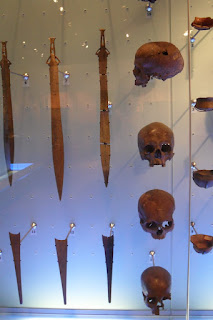
According to their website, this library has been "the place" for poetry in Scotland since 1984. The focus is on contemporary poetry from Scotland, however there are historic poems and poems from across the globe. It is a lending library where books, audio, videos, magazines and more can be checked out or even mailed to a patron. There are about 11 staff members who coordinate performances, special events and children's events. They also are very active with school programs, running workshops, competitions, lesson plans and more.
My favorite part of their website is the "Lost for Words" section. If you have a poem that you can only remember a few lines-post it and the library will help find the poem! There is an archive of 'lost and found' poems they have been able to help patrons find.

I enjoyed the Children's Section, pictured above, where kids can read, relax and learn. On the wall there is a large poem about the Loch Ness monster's song. It is very funny and creative. I probably would not have noticed it if someone didn't point it out to me. It is pictured below so you can share in on the silliness! It was interesting to see how much material there is for children about poetry. It is great that there is a main focus like this to get children motivated about poetry. I used to write when I was younger, and this really sparked some memories. It is my hope that this library continues to flourish so children can make their own memories from what they encounter here. There are toys, books, puzzles, a table and chairs as well as cushions that look like they are for story time.

The Poetry Library is funded by donations, the Scottish Arts Council and the National Lottery. The librarian on duty was very busy and didn't have much time to answer our questions-but it was great to explore this gem of a library. I like the idea of what they promote, and they seem very modern and organized. There is almost nothing better than bringing people and poetry together; their mission-in progress.
Visit them online at http://www.spl.org.uk/index.html
























 National Art Library
National Art Library



















 St. Paul's Cathedral has existed in one form or another at this site for about 1,400 years. Walk up the beautiful spiral staircase (picture the Harry Potter staircase!) and behind closed doors is a fantastic old library-closed to the public. Unlock with a great, old fashioned key and enter a world of incredibly preserved books and the classic smell of an old library. The library at St. Paul's Cathedral was seriously impressive and left me in awe. The Great Fire of 1666 destroyed the original collection, however it was built up again starting in 1712. The image here, obtained from
St. Paul's Cathedral has existed in one form or another at this site for about 1,400 years. Walk up the beautiful spiral staircase (picture the Harry Potter staircase!) and behind closed doors is a fantastic old library-closed to the public. Unlock with a great, old fashioned key and enter a world of incredibly preserved books and the classic smell of an old library. The library at St. Paul's Cathedral was seriously impressive and left me in awe. The Great Fire of 1666 destroyed the original collection, however it was built up again starting in 1712. The image here, obtained from 
